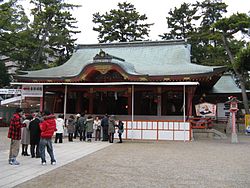- Nagata jinja
-
Nagata jinja
長田神社
Nagata jinja Information Founded 201 Founder(s) Empress Jingū Address Kobe, Nagata-ku Nagata-cho 3-1-1 Phone 078-691-0333 Website Homepage Nagata jinja (長田神社 ) is a Shinto shrine in Nagata Ward, Kobe, Japan.[1] At Nagata, Kotoshironushi-no-Okami is enshrined.[2]
The shrine is associated with Amaterasu, who is said to have told Empress Jingū that a shrine was wanted at Nagata.[3]
Contents
History
According to Nihon Shoki, Nagata was founded by the Empress Jingū at the beginning of the 3rd century along with Hirota Shrine. In 2001, the shrine celebrated its 1,800 years of history.[2]
From 1871 through 1946, the Nagata was officially designated one of the kanpei-chūsha (官幣中社),[4] meaning that it stood in the second tier of government supported shrines which were especially venerated by the imperial family.
Nagata is related to Sumiyoshi Taisha and Ikuta Shrine.[citation needed]
Festivals and events
An autumn matsuri in October is a special day (en'nichi) for the kami Kotoshironushi.[5]
A setsubun observance in February is the Tsuina-shiki Shinji, which engages hopes for safety in the home and averting misfortune.[6] This Shinto purification ritual is designated as an intangible cultural heritage event.[2] The elaborate ceremony is a pantomime representation of driving out demons or bad spirits.[7]
See also
Notes
- ^ Richard, Ponsonby-Fane. (1964) Visiting Famous Shrines in Japan, pp. 324-328.
- ^ a b c Kobe Convention and Visitors Association, Nagata Jinja Shrine
- ^ Ponsonby-Fane, p, 321.
- ^ Ponsonby-Fane, p. 322.
- ^ Librarie Sansaisha. (1907). "L'anéee 1907 au japon d'aprés l'ancien et le nouveau calendrier," in Mélanges japonais. Vol. 4, No 13, p. 122. at Google Books; Encyclopedia of Shinto, En'nichi; retrieved 2011-08-19
- ^ Encyclopedia of Shinto, Tsuina shiki; Engimono; retrieved 2011-08-19
- ^ Ponsonby-Fane, pp. 327-328.
References
- Ponsonby-Fane, Richard. (1964). Visiting Famous Shrines in Japan. Kyoto: Ponsonby-Fane Memorial Society. OCLC 1030156
External links
- Nagata jinja official website (Japanese)
Coordinates: 34°40′17″N 135°08′49″E / 34.67139°N 135.14694°E
Shinto shrine Shinto architecture Buildings - chōzuya or temizuya
- haiden
- heiden
- hokora
- honden / shinden / shōden
- kagura-den
- massha
- sessha
Architectonic elements Styles - hirairi-zukuri
- tsumairi-zukuri
- gongen-zukuri
- hachiman-zukuri
- hiyoshi-zukuri
- irimoya-zukuri
- ishi-no-ma-zukuri
- kasuga-zukuri
- kibitsu-zukuri
- misedana-zukuri
- nagare-zukuri
- ōtori-zukuri
- owari-zukuri
- ryōnagare-zukuri
- shinmei-zukuri
- sumiyoshi-zukuri
- taisha-zukuri
Others Implements Main kami Staff Head shrines1 - Fushimi Inari Taisha
- Usa Hachiman-gū
- Ise Grand Shrine
- Dazaifu Tenman-gū
- Munakata Taisha
- Suwa Taisha
- Hiyoshi Taisha
- Kumano Nachi Taisha
- Tsushima Shrine
- Yasaka Shrine
Miscellaneous 1 (in order of the size of the shrine network they head)
Categories:- 3rd-century establishments
- Kobe
- Shinto shrines in Hyōgo Prefecture
- Visitor attractions in Hyōgo Prefecture
- Shinto stubs
Wikimedia Foundation. 2010.
